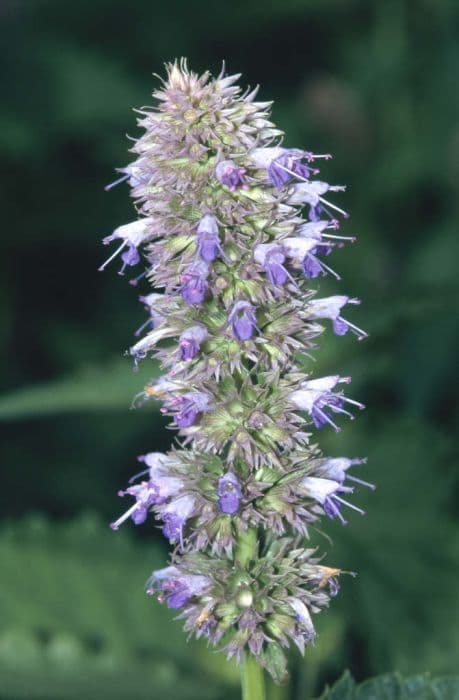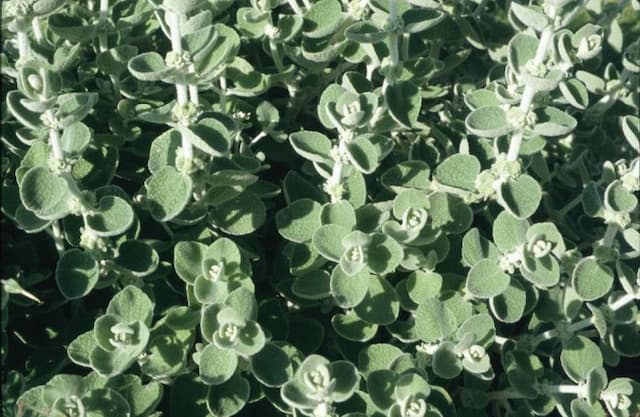White Deadnettle Lamium album

ABOUT
Lamium album, commonly known as white dead-nettle, has a striking appearance characterized by its square stems and heart-shaped, toothed leaves. The leaves are often arranged in opposing pairs along the stem. This lush foliage provides a vivid green backdrop for the plant's most eye-catching feature, its delicate white flowers. These flowers form in dense whorls at the leaf axils and resemble miniature snapdragons due to their tubular shape with a hooded upper lip and a three-lobed lower lip. The blooms present a stark contrast to the green leaves and tend to attract various pollinators. White dead-nettle is a resilient plant that can often be found thriving in a variety of habitats, lending its ornamental beauty to both cultivated gardens and wilder landscapes.
About this plant
 Names
NamesFamily
Lamiaceae.
Synonyms
White Nettle, White Dead-Nettle, Blind Nettle, Dumb Nettle, Bee Nettle, Archangel.
Common names
Lamium album var. barbatum, Lamium album subsp. barbatum, Lamium album var. crinitum, Lamium album var. lanatum, Lamium album var. molle, Lamium album var. pubescens, Galeobdolon album.
 Toxicity
ToxicityTo humans
White deadnettle (Lamium album) is not considered toxic to humans. In fact, various parts of the plant, such as leaves and flowers, have been used traditionally in herbal medicine and as edible plants without widespread reports of adverse effects. However, like with any plant, individual allergies or sensitivities can occur. If one were to experience an adverse reaction after ingesting white deadnettle, it could potentially be due to a personal sensitivity, and medical attention should be sought.
To pets
White deadnettle (Lamium album) is not known to be toxic to pets. It is generally considered safe, and there are no well-documented cases of poisoning in domestic animals from consuming this plant. However, as with any non-typical food, white deadnettle could potentially cause mild gastrointestinal upset in some pets if they were to ingest large quantities. If you suspect your pet has eaten a large amount of white deadnettle and is showing signs of distress, it is advisable to consult a veterinarian.
 Characteristics
CharacteristicsLife cycle
Perennials
Foliage type
Deciduous
Color of leaves
Green
Flower color
White
Height
1-2 feet (30-60 cm)
Spread
1-3 feet (30-90 cm)
Plant type
Herb
Hardiness zones
3
Native area
Europe
Benefits
 General Benefits
General Benefits- Wildlife Attraction: White deadnettle is known for attracting bees, beneficial insects, butterflies/moths and other pollinators, making it an excellent choice for supporting local ecosystems.
- Low Maintenance: This plant is robust and adaptable, often requiring minimal care once established, making it suitable for low-maintenance gardens.
- Shade Tolerance: White deadnettle can grow in shaded areas where other plants might struggle, which is beneficial for underplanting or filling in dark garden spots.
- Ground Cover: It spreads effectively to cover bare ground, helping to prevent soil erosion and suppress weed growth.
- Ornamental Use: With its attractive white flowers, it can add aesthetic value to gardens and landscapes.
- Culinary Use: Young leaves and flowers can be used in salads and as an herb, offering a mild, slightly mushroom-like flavor.
- Companion Planting: It can be planted alongside vegetable crops to attract pollinators and improve yield.
 Medical Properties
Medical Properties- Astringent: Lamium album, commonly known as white nettle, has astringent properties that may help tighten and tone tissues.
- Anti-inflammatory: It is traditionally used to reduce inflammation and may help in treating conditions with inflammatory components.
- Diuretic: White nettle has diuretic properties which might assist in the removal of excess water and toxins from the body through urine.
- Emmenagogue: It was historically used to promote menstrual flow and to treat various menstrual disorders.
- Expectorant: The plant has been used to facilitate the removal of mucus from the respiratory tract.
- Vulnerary: With its vulnerary properties, white nettle might be beneficial in wound healing and in the treatment of minor skin injuries.
- Antiseptic: It may have been used for its antiseptic effects to help prevent the growth of microorganisms.
 Air-purifying Qualities
Air-purifying QualitiesThis plant is not specifically known for air purifying qualities.
 Other Uses
Other Uses- Lamium album, commonly known as white dead-nettle, can be used as a natural dye source, providing varying shades of green and yellow depending on the mordant used.
- The soft fibers of the plant have been historically used for making fine nets and cheesecloth due to their durability and texture.
- Leaves of the white dead-nettle can be cooked like spinach, and their mild flavor works well in soups and stews.
- The flowers, being edible, can be added to salads or used as garnish for a touch of sweetness and decoration.
- Dried white dead-nettle can serve as a stuffing material for herbal pillows, often combined with other herbs to create a soothing scent.
- White dead-nettle has been utilized in companion planting to attract beneficial insects such as bees and butterflies to gardens.
- It can be used as a natural fertilizer, as the plant, when composted, enriches the soil with nitrogen.
- The plant has been used in folk crafts to make herbal sachets and potpourris, providing a pleasant aroma.
- Farmers sometimes plant white dead-nettle as a forage crop for livestock, particularly for sheep and goats.
- If grown as ground cover, white dead-nettle can also prevent soil erosion and suppress the growth of weeds with its dense foliage.
Interesting Facts
 Feng Shui
Feng ShuiWhite nettle is not used in Feng Shui practice.
 Zodiac Sign Compitability
Zodiac Sign CompitabilityWhite nettle is not used in astrology practice.
 Plant Symbolism
Plant Symbolism- Purity - Lamium album, commonly known as white nettle or white dead-nettle, has white flowers which are often associated with purity, much like other white-flowered plants.
- Concealment - The plant's ability to blend in with stinging nettles without the sting itself implies a symbolism of disguise or concealment.
- Perseverance - White nettles are hardy and can thrive in adverse conditions, symbolizing the ability to persist and adapt.
- Healing - Historically, white nettle has been used in herbal medicine for various ailments, representing healing and relief.
- Motherhood - Due to its traditional uses in treating female reproductive issues, it can be symbolic of motherhood and fertility.
 Water
WaterWhite Dead Nettle should be watered thoroughly, ensuring that the soil is kept moist but not soggy. Typically, this may mean watering the plant once a week with approximately a quart of water, depending on the size of the pot and the environmental conditions. It's important not to let the soil dry out completely, especially during the active growing season in spring and summer. In winter, reduce watering to every other week, but monitor the soil moisture closely as indoor heating can dry out the soil faster. Water at the base of the plant to avoid wetting the foliage, which can lead to fungal diseases.
 Light
LightWhite Dead Nettle prefers partial shade to full shade conditions. The best spot for this plant is in an area that receives bright, indirect sunlight or dappled shade. A north-facing or east-facing window would be ideal for indoor specimens, while an outdoor setting under a canopy of trees or on the north side of a building can provide the optimal light environment. Avoid placing it under direct intense sunlight, especially during the heat of the day, as this can scorch the leaves.
 Temperature
TemperatureWhite Dead Nettle thrives in moderate temperature conditions, ideally between 60 and 75 degrees Fahrenheit. It can survive minimum temperatures down to 30 degrees Fahrenheit, making it relatively hardy against frost, but should not be exposed to prolonged freezing temperatures. The plant performs best in the cooler temperature range and might require protection from extreme heat above 80 degrees Fahrenheit.
 Pruning
PruningWhite Dead Nettle benefits from pruning to maintain its shape and encourage bushier growth. Trim back leggy stems and any dead or damaged foliage in early spring to stimulate new growth. Pruning can be done again after the plant has flowered to promote a second bloom. The best time for general pruning is in the spring or immediately after the first flowering period.
 Cleaning
CleaningAs needed
 Soil
SoilWhite Dead Nettle thrives in well-draining soil rich in organic matter with a soil pH ranging from 6.0 to 7.5. The best soil mix for White Dead Nettle can be prepared by mixing loamy garden soil with compost or well-rotted manure and adding a portion of sand or perlite to ensure good drainage.
 Repotting
RepottingWhite Dead Nettle does not require frequent repotting and can be repotted every 2 to 3 years or when it outgrows its current container. Monitor the plant for signs of root crowding, and choose a pot that is slightly larger than the current one.
 Humidity & Misting
Humidity & MistingWhite Dead Nettle is tolerant of a range of humidity levels and does not have specific humidity requirements, making it adaptable to typical indoor environments. However, it does benefit from a moderately humid atmosphere.
 Suitable locations
Suitable locationsIndoor
Place White Dead Nettle in bright, indirect light and water regularly.
Outdoor
Plant in partial shade, keep soil moist, and protect from harsh sun.
Hardiness zone
3-9 USDA
 Life cycle
Life cycleWhite dead nettle (Lamium album) begins its life cycle as a seed, which germinates in spring in a suitable environment with moist, fertile soil. The seedling stage follows, characterized by the emergence of the cotyledons and subsequent true leaves, as the plant establishes its root system. As it matures, the plant enters the vegetative stage, during which it develops a squared stem typical of members of the mint family, heart-shaped leaves, and a branching habit. The reproductive stage is marked by the emergence of its distinct white flowers arranged in whorls around the stem, which are pollinated by bees and other insects. After pollination, the plant produces fruit in the form of nutlets that contain the seeds for the next generation. White dead nettle is a perennial plant, so it may not die after one season, instead it may enter a period of dormancy over winter and regrow from its rootstock the following spring.
 Propogation
PropogationPropogation time
Spring to Summer
White deadnettle, or Lamium album, is commonly propagated through division, which is the most popular method. The ideal time for dividing white deadnettle plants is in spring as the new growth emerges, or in fall, after the blooming period is over and the plant is preparing for dormancy. To propagate through division, gently dig up the entire plant, making sure to keep as much of the root system intact as possible. Then, using a sharp spade or knife, carefully separate the plant into smaller sections, each with a portion of the roots attached. These divisions should then be replanted at the same depth they were previously growing in well-draining soil, spaced approximately 12 inches (about 30 centimeters) apart to allow sufficient room for growth. Water the new divisions thoroughly after planting to help establish them. Division not only helps to propagate white deadnettle but it also invigorates the parent plant and helps keep it healthy and robust.









